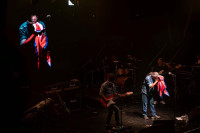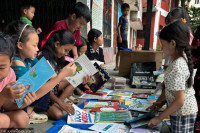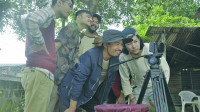Entertainment
What echoed in the Valley?
Ason, Kathmandu’s oldest marketplace, reverberated with a day-long music festival on Saturday.
Sanjit Bhakta Pradhananga
Ason, Kathmandu’s oldest marketplace, reverberated with a day-long music festival on Saturday. Spread over seven different locations in the historic old district, the festival—Echoes in the Valley—saw small neighbourhoods, dabalis and bahals, converted into grand stages, with dozens of international and local artists performing throughout the day.
But more than being just another music festival in the Capital, organisers and locals believe that Echoes was significant because it showcased how traditional public spaces can be repurposed to host modern events. Effectively following previous events like Photo Kathmandu—which converted the labyrinthine gallis of Patan into a giant art gallery—and Bato Ko Cinema, which recasts public water fountains and squares as open-air cinemas, Echoes in the Valley was the first music and arts festival of its kind held in Kathmandu’s old district.

Rizu Tuladhar, a member of the folk-fusion ensemble Kanta dAb dAb and one of the organisers for the fest, spoke of how the early inspirations for the music festival came about. “When we were on a tour of Europe with the band last year, one thing that was consistent wherever we went was that there were always local artists busking on the streets. They were not doing it at any amphitheatres or venues, just on street corners and parks.” At the time, Tuladhar remembers joking with band mates that playing music in public spaces was a longstanding tradition in the Valley, and that the Hippies must have brought it back to Europe from Kathmandu. “It made us think about how these traditions were disappearing in the Valley and how it needed to be revived. We don’t need to busk at street corners here in Kathmandu; we already have countless satahs (satals) and dabbus (dabalis) that were designed for this exact purpose. All we need to do is reach out and reclaim it.”
Sangam Pantha, a member of Project Sarangi, who played a set at the Balkumari Satah, said, “We have been hosting the ‘Sarangi Month’ and have played at several hip and trendy venues around town recently. Today we played here at this traditional satah and the vibe was completely different—unlike anything I’ve experienced before. It made me think of all the musicians that must have played here over the centuries and it was great to be part of an effort to give those traditions continuation.”
Indra Maharjan, an Ason local whose family has had a shop at the Balkumari Satah for three generations, was overjoyed to see his store front converted into a musical venue. “There used to be a Bhajan mandali that played here until a generation ago but the satah hadn’t seen a musical performance like this in more than a decade. It has been a revelation of sorts. I, for one, did not think that this very public space could have been repurposed like this. It gives the community a lot of ideas for the future.”
The festival, which stretched through the entire day, saw an amalgamation of eastern and western sounds with traditional bhajan mandalis playing alongside international artists like the Helsinki Uniarts Collective and Daniel Givone. Popular folk-fusion ensembles like the Hari Maharjan Project, Kanta dAb dAb and Night were also on stage alongside emerging student bands like Ma and Cycle. “This is a microcosm of the Nepali soundscape,” said Tuladhar, “Yes there was an emphasis on traditional sounds at the fest, but a younger generation of musicians are also showcasing how the barriers of what is traditional can be pushed and redefined. That has been a major takeaway as well.”
Echoes in the Valley also saw two workshops for children, a spoken word poetry performance, guided tours of the neighbourhood by a local historian, and a photo exhibition of archived photographs supported by the Nepal Picture Library.




 17.91°C Kathmandu
17.91°C Kathmandu










